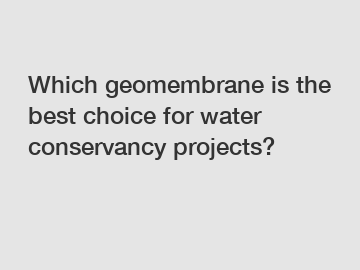Which geomembrane is the best choice for water conservancy projects?
Water conservancy projects play a crucial role in ensuring the sustainable utilization and management of our water resources. Geomembranes, a vital component of such projects, serve as impermeable barriers to prevent seepage and ensure the containment of water. However, selecting the most suitable geomembrane for water conservancy projects requires careful consideration of several factors, ranging from durability to cost-effectiveness. In this blog, we will unravel the top choices when it comes to geomembranes, providing you with the necessary insight to make an informed decision.
1. HDPE (High-Density Polyethylene):
HDPE geomembranes offer an excellent choice for water conservancy projects due to their incredible durability, high chemical resistance, and low permeability. These geomembranes are manufactured using high-density polyethylene resins, ensuring longevity and effective containment of water. Additionally, HDPE geomembranes have a proven track record in diverse applications, including reservoirs, dams, canals, and wastewater treatment systems.

2. PVC (Polyvinyl Chloride):
PVC geomembranes, composed of polyvinyl chloride, are another reliable choice for water conservancy projects. These geomembranes possess high resistance to punctures, tear propagation, and UV degradation. PVC geomembranes offer flexibility, allowing for easy installation even in complex landscapes. Moreover, their low permeability and chemical resistance make them suitable for various water containment applications in water conservancy projects.
3. EPDM (Ethylene Propylene Diene Monomer):
EPDM geomembranes have gained popularity in water conservancy projects for their remarkable resistance to weathering and ozone effects. Made of synthetic rubber, EPDM geomembranes exhibit robust performance, particularly when used in exposed applications such as canals, lakes, and reservoirs. These geomembranes can withstand extreme temperature fluctuations and provide a secure barrier against harmful chemicals.
4. LLDPE (Linear Low-Density Polyethylene):
LLDPE geomembranes, formulated with linear low-density polyethylene resins, are widely recognized for their flexibility and ease of installation. Their resistance to puncture and impact, superior tensile strength, and excellent elongation properties make them a suitable choice for water conservancy projects. LLDPE geomembranes adapt well to irregular surfaces, reducing the occurrence of leaks and improving overall water containment efficiency.
5. Conductive Geomembranes:
For certain water conservancy projects that involve harmful chemicals or require significant management of static electricity, conductive geomembranes are the ideal choice. These specialized geomembranes consist of a conductive layer sandwiched between two standard geomembrane layers, offering safety and protection against electrical hazards. Conductive geomembranes are primarily used in applications such as chemical storage ponds, hazardous waste sites, and power station reservoirs.
6. Reinforced Geomembranes:
When faced with challenging soil conditions or the need for additional tensile strength, reinforced geomembranes provide an optimal solution. Reinforced geomembranes combine the advantages of traditional geomembranes with a reinforcing layer, typically made of polyester or fiberglass. These geomembranes offer enhanced tear strength and puncture resistance, making them suitable for high-stress situations in water conservancy projects.
Conclusion:
Selecting the most suitable geomembrane for water conservancy projects is a critical decision that demands expertise and consideration of various factors. HDPE, PVC, EPDM, LLDPE, conductive, and reinforced geomembranes are among the top choices, each offering unique benefits based on specific project requirements. Consider factors such as durability, chemical resistance, permeability, and cost-effectiveness when making your decision. Engaging professional guidance and collaborating with experienced suppliers will ensure the best outcome for your water conservancy project.
Are you interested in learning more about trp geomembranes, geotube manufacturer, Cement Blanket Supplier? Contact us today to secure an expert consultation!

Comments
0